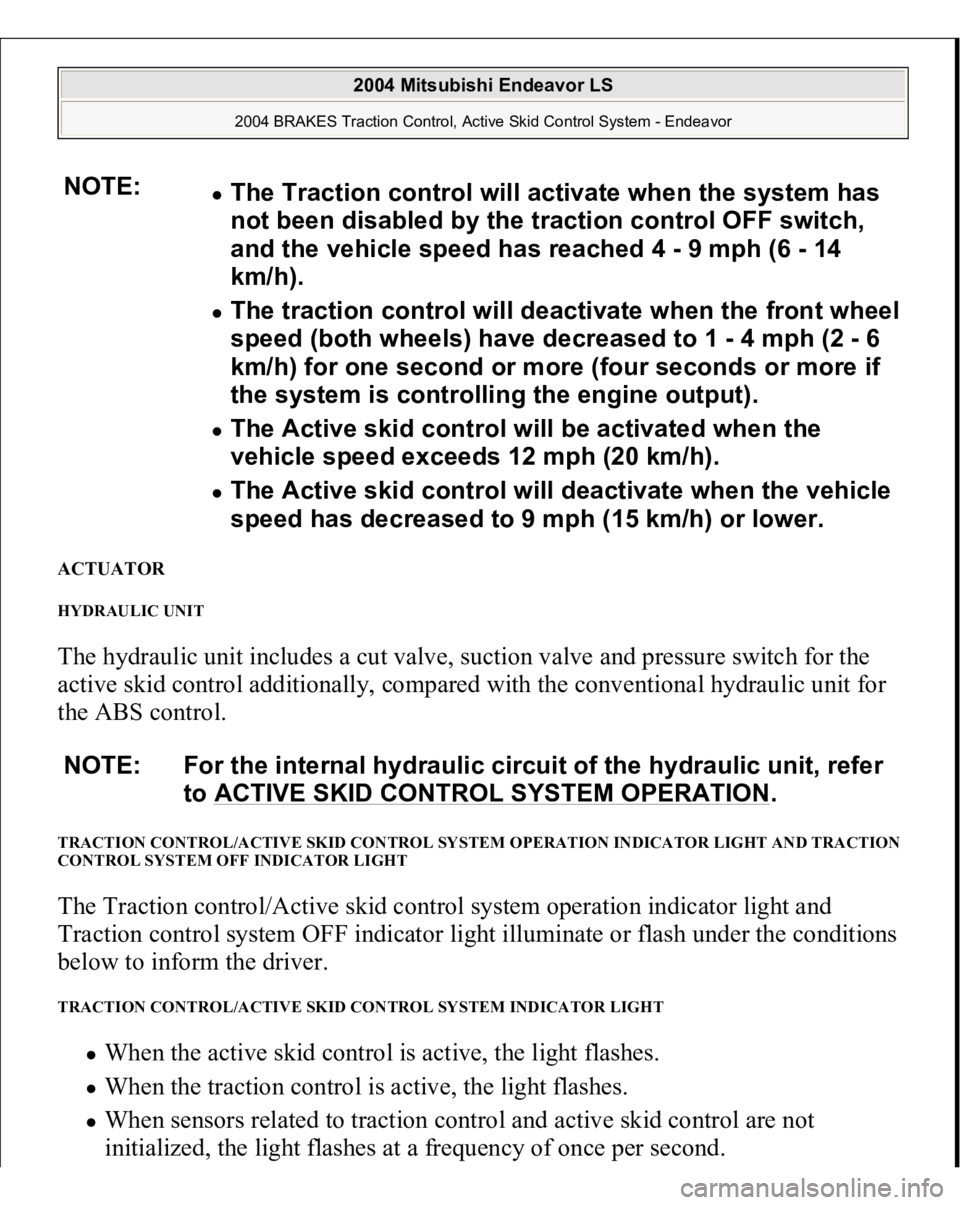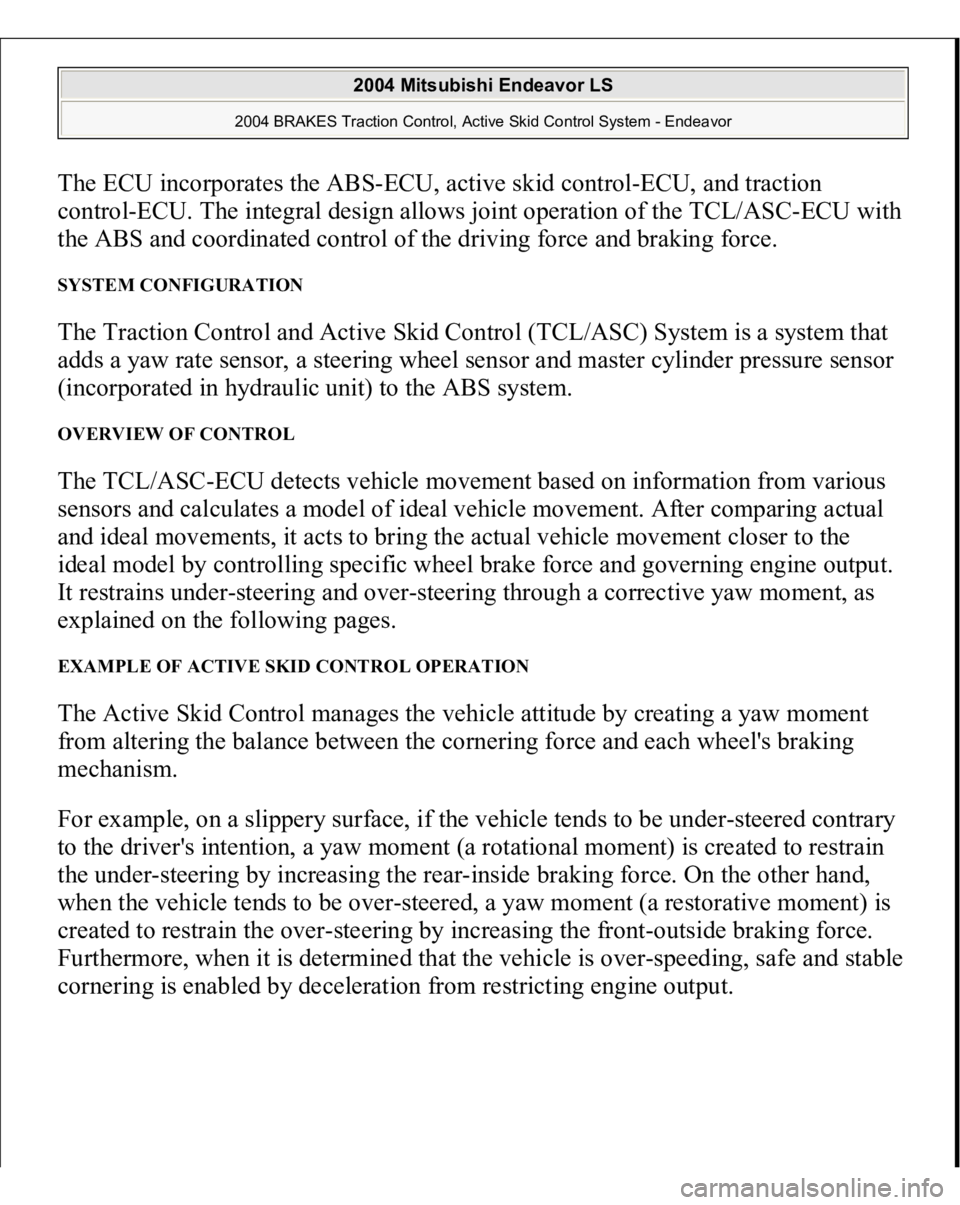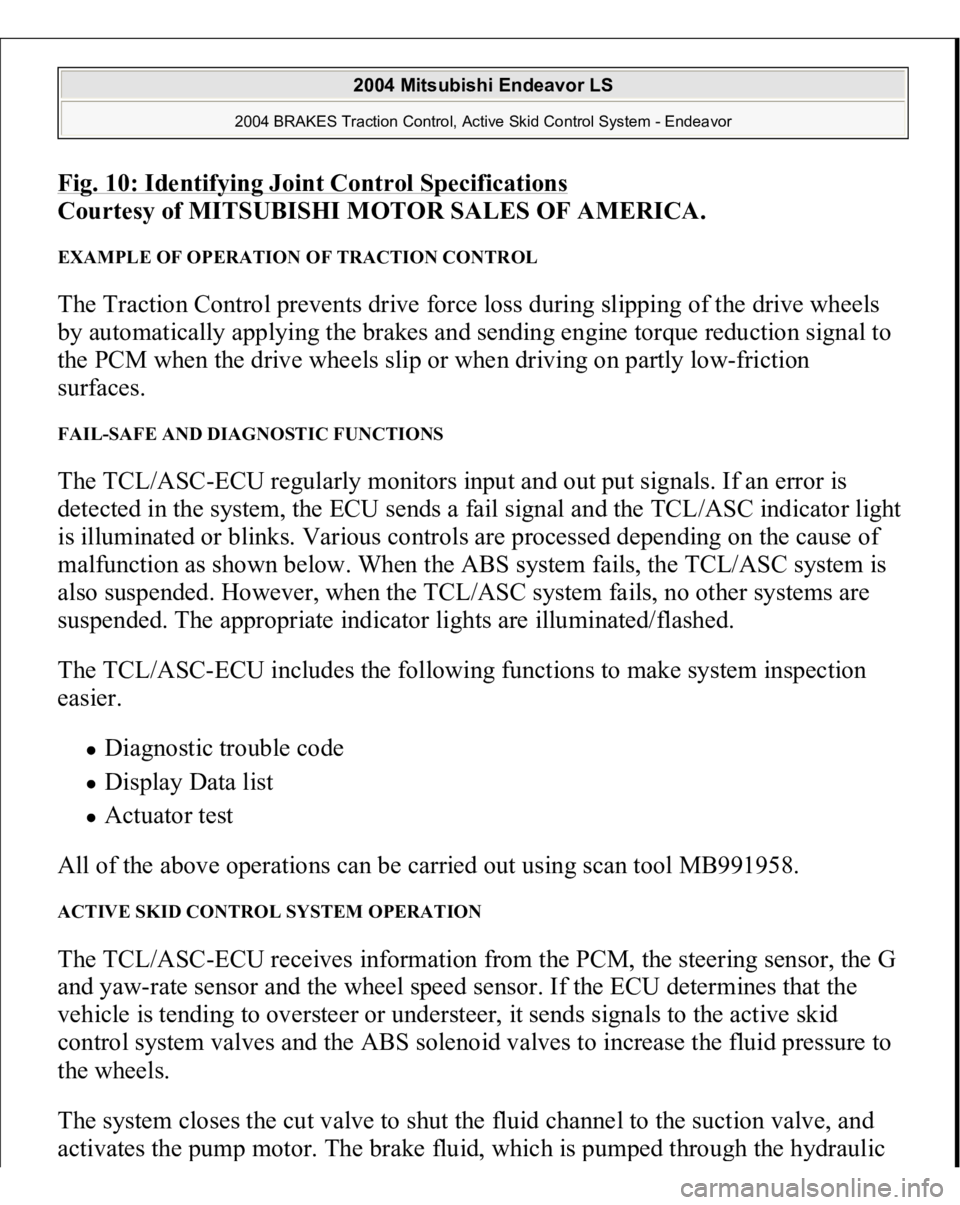Page 3115 of 3870

ACTUATOR HYDRAULIC UNIT The hydraulic unit includes a cut valve, suction valve and pressure switch for the
active skid control additionally, compared with the conventional hydraulic unit for
the ABS control. TRACTION CONTROL/ACTIVE SKID CONTROL SYSTEM OPERATION INDICATOR LIGHT AND TRACTION
CONTROL SYSTEM OFF INDICATOR LIGHT The Traction control/Active skid control system operation indicator light and
Traction control system OFF indicator light illuminate or flash under the conditions
below to inform the driver. TRACTION CONTROL/ACTIVE SKID CONTROL SYSTEM INDICATOR LIGHT
When the active skid control is active, the light flashes. When the traction control is active, the light flashes. When sensors related to traction control and active skid control are not
initialized, the li
ght flashes at a fre
quenc
y of once
per second.
NOTE:
The Traction control will activate when the system has
not been disabled by the traction control OFF switch,
and the vehicle speed has reached 4 - 9 mph (6 - 14
km/h). The traction control will deactivate when the front wheel
speed (both wheels) have decreased to 1 - 4 mph (2 - 6
km/h) for one second or more (four seconds or more if
the system is controlling the engine output). The Active skid control will be activated when the
vehicle speed exceeds 12 mph (20 km/h). The Active skid control will deactivate when the vehicle
speed has decreased to 9 mph (15 km/h) or lower.
NOTE: For the internal hydraulic circuit of the hydraulic unit, refer
to ACTIVE SKID CONTROL SYSTEM OPERATION
.
2004 Mitsubishi Endeavor LS
2004 BRAKES Traction Control, Active Skid Control System - Endeavor
Page 3117 of 3870

The ECU incorporates the ABS-ECU, active skid control-ECU, and traction
control-ECU. The integral design allows joint operation of the TCL/ASC-ECU with
the ABS and coordinated control of the driving force and braking force. SYSTEM CONFIGURATION The Traction Control and Active Skid Control (TCL/ASC) System is a system that
adds a yaw rate sensor, a steering wheel sensor and master cylinder pressure sensor
(incorporated in hydraulic unit) to the ABS system. OVERVIEW OF CONTROL The TCL/ASC-ECU detects vehicle movement based on information from various
sensors and calculates a model of ideal vehicle movement. After comparing actual
and ideal movements, it acts to bring the actual vehicle movement closer to the
ideal model by controlling specific wheel brake force and governing engine output.
It restrains under-steering and over-steering through a corrective yaw moment, as
explained on the following pages. EXAMPLE OF ACTIVE SKID CONTROL OPERATION The Active Skid Control manages the vehicle attitude by creating a yaw moment
from altering the balance between the cornering force and each wheel's braking
mechanism.
For example, on a slippery surface, if the vehicle tends to be under-steered contrary
to the driver's intention, a yaw moment (a rotational moment) is created to restrain
the under-steering by increasing the rear-inside braking force. On the other hand,
when the vehicle tends to be over-steered, a yaw moment (a restorative moment) is
created to restrain the over-steering by increasing the front-outside braking force.
Furthermore, when it is determined that the vehicle is over-speeding, safe and stable
cornerin
g is enabled b
y deceleration from restrictin
g en
gine out
put.
2004 Mitsubishi Endeavor LS
2004 BRAKES Traction Control, Active Skid Control System - Endeavor
Page 3119 of 3870
Fig. 9: Identifying Examples Of The Effect Of Control
Courtesy of MITSUBISHI MOTOR SALES OF AMERICA.
JOINT CONTROL The Active Skid Control transmits data necessary for control of the ABS and the
Traction Control, performing joint control.
2004 Mitsubishi Endeavor LS
2004 BRAKES Traction Control, Active Skid Control System - Endeavor
Page 3120 of 3870

Fig. 10: Identifying Joint Control Specification
s
Courtesy of MITSUBISHI MOTOR SALES OF AMERICA.
EXAMPLE OF OPERATION OF TRACTION CONTROL The Traction Control prevents drive force loss during slipping of the drive wheels
by automatically applying the brakes and sending engine torque reduction signal to
the PCM when the drive wheels slip or when driving on partly low-friction
surfaces. FAIL-SAFE AND DIAGNOSTIC FUNCTIONS The TCL/ASC-ECU regularly monitors input and out put signals. If an error is
detected in the system, the ECU sends a fail signal and the TCL/ASC indicator light
is illuminated or blinks. Various controls are processed depending on the cause of
malfunction as shown below. When the ABS system fails, the TCL/ASC system is
also suspended. However, when the TCL/ASC system fails, no other systems are
suspended. The appropriate indicator lights are illuminated/flashed.
The TCL/ASC-ECU includes the following functions to make system inspection
easier.
Diagnostic trouble code Display Data list Actuator test
All of the above operations can be carried out using scan tool MB991958.
ACTIVE SKID CONTROL SYSTEM OPERATION The TCL/ASC-ECU receives information from the PCM, the steering sensor, the G
and yaw-rate sensor and the wheel speed sensor. If the ECU determines that the
vehicle is tending to oversteer or understeer, it sends signals to the active skid
control system valves and the ABS solenoid valves to increase the fluid pressure to
the wheels.
The system closes the cut valve to shut the fluid channel to the suction valve, and
activates the
pum
p motor. The brake fluid, which is
pum
ped throu
gh the h
ydraulic
2004 Mitsubishi Endeavor LS
2004 BRAKES Traction Control, Active Skid Control System - Endeavor
Page 3122 of 3870
Fig. 12: Status Of Operation Valve Specification
Courtesy of MITSUBISHI MOTOR SALES OF AMERICA.
WHEN THE ABS FLUID PRESSURE IS DECREASING Fig. 13: ABS Fluid Pressure Is Decreasing Diagram
Courtesy of MITSUBISHI MOTOR SALES OF AMERICA.
The system closes the inlet solenoid valve to shut the fluid channel from the master
c
ylinder, and o
pens the outlet solenoid valve to return the brake fluid from the
2004 Mitsubishi Endeavor LS
2004 BRAKES Traction Control, Active Skid Control System - Endeavor
Page 3123 of 3870
wheel cylinders to the buffer chamber. This causes the wheel cylinder fluid pressure
to decrease. Then the system activates the pump motor to return the brake fluid
from the buffer chamber to the hydraulic unit reservoir.
Fig. 14: Status Of Operation Valve Specification
Courtesy of MITSUBISHI MOTOR SALES OF AMERICA.
WHEN THE ABS FLUID PRESSURE IS HOLDING Fig. 15: ABS Fluid Pressure Is Holding Diagram
2004 Mitsubishi Endeavor LS
2004 BRAKES Traction Control, Active Skid Control System - Endeavor
Page 3124 of 3870
Courtesy of MITSUBISHI MOTOR SALES OF AMERICA
.
The system closes the inlet solenoid valve and the outlet solenoid valve to hold the
brake fluid pressure in the wheel cylinders.
Fig. 16: Status Of Operation Valve Specification
Courtesy of MITSUBISHI MOTOR SALES OF AMERICA.
WHEN THE ABS FLUID PRESSURE IS INCREASING
2004 Mitsubishi Endeavor LS
2004 BRAKES Traction Control, Active Skid Control System - Endeavor
Page 3125 of 3870
Fig. 17: ABS Fluid Pressure Is Increasing Diagra
m
Courtesy of MITSUBISHI MOTOR SALES OF AMERICA.
The system opens the inlet solenoid valve and closes the outlet solenoid valve to
increase the brake fluid pressure in the wheel cylinders.
Fig. 18: Status Of Operation Valve Specification
Courtesy of MITSUBISHI MOTOR SALES OF AMERICA.
WHEN THE TRACTION CONTROL SYSTEM IS INCREASING FLUID PRESSURE (OR THE ACTIVE SKID
CONTROL IS INCREASING FLUID PRESSURE WHEN THE BRAKE PEDAL IS NOT DEPRESSED)
2004 Mitsubishi Endeavor LS
2004 BRAKES Traction Control, Active Skid Control System - Endeavor